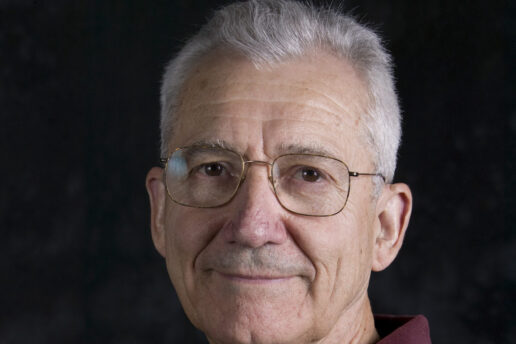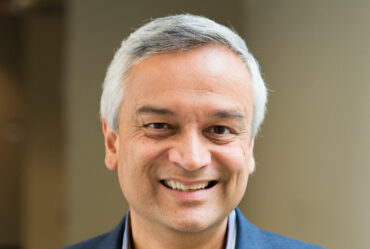
American Physical Society honors Wit Busza with the Tom W. Bonner Prize in Nuclear Physics
Wit Busza, the Francis L. Friedman Professor of Physics, Emeritus, and researcher in the Laboratory for Nuclear Science, has been awarded the American Physical Society’s Tom W. Bonner Prize in Nuclear Physics “for pioneering work on multi-particle production in proton-nucleus and nucleus-nucleus collisions, including the discovery of participant scaling, and for the conception and leadership of the PHOBOS experiment.”
The prize recognizes outstanding experimental research in nuclear physics, including the development of a method, technique, or device that significantly contributes to nuclear physics research.
When two protons or nuclei travelling at close to the speed of light collide, a vast number of particles are created. It is a distinct example of energy converting to mass.As an example, when lead nuclei collide in the highest energy colliders, one often sees over 10,000 protons, neutrons, antiprotons, pi-mesons etc. streaming out from the tiny volume where the collision took place.
“It’s amazing if you consider that this volume is no larger than that of a mere 100 or so of such particles,” Busza says. “The question arises: what exactly is this extremely hot (more than a billion times higher temperature than the surface of the sun) and super dense stuff, which was produced in the collision, before it evolved into the observed large number of created particles? It is a particularly interesting question since we think it is the same stuff, named the quark-gluon plasma, out of which most of our universe was made at about 10 microseconds after the Big Bang.”
It is the question that has fascinated Busza throughout his research career. He has originated and led experiments that study the process of multi–particle production, in particular the space-time evolution of the process, the stopping power of nuclear forces,and the maximum energies achieved in heavy ion collisions.
In the 1980s, Brookhaven National Laboratory (BNL) decided to build the first relativistic heavy ion collider (RHIC) in which they would collide gold nuclei with each other up to an energy of 100 GeV per nucleon in each gold nucleus. The hope was that that would be enough to create the quark-gluon plasma. In 1989, BNL decided that four detectors should be built to study the collisions produced in the RHIC. There was a call for proposals to design and build the detectors.
“I brought together at MIT particle and nuclear physicists to form the Relativistic Heavy Ion Group (RHIG), and with this group as the core we formed an international collaboration of some 60 physicists, engineers and technicians,” says Busza. “This collaboration proposed a detector which was called Modular Array for Rhic Spectra, MARS, for short. The estimated cost was over 10 million dollars. MARS was rejected, primarily because of the high cost. This was very fortunate since, in retrospect, it was not such a brilliant proposal! We reduced the scope of the proposal and came up with a much better detector and research program, which not only was accepted but also attracted some superb collaborators.”
He added, “PHOBOS turned out to be a superb well-focused detector. It produced the first physics results from RHIC, in a short time. They had a preliminary result within 12 hours of first collisions and an accepted Physical Review Letters’ paper in six weeks.Furthermore, together with the other 3 RHIC detectors, it participated in the observation that the system produced at RHIC is a very strongly interacting QCD liquid, with a surprising extremely low viscosity to entropy ratio.”
On some of the major reasons for the success of his efforts, Busza recalls his early days at MIT as an assistant professor, when he didn’t have much in research funding. “But I had something much more important — a fantastic collegial, supportive and encouraging department. In particular, Professors Jerome Friedman, David Frisch, Henry Kendall, and Larry Rosenson generously shared with me their graduate students, technicians, equipment and discretionary funds. This made it possible to launch my studies of pA collisions, which turned out to be more influential than my wildest expectations at that time.”
In their letter nominating Busza for the Bonner, MIT Professor of Physics and LNS researcher Gunther Roland and Professor of Physics and LNS Director Boleslaw Wyslouch wrote, “Throughout his career, Wit has asked profound questions about the fundamental nature of nuclear collisions. He has then often been the first to answer them, using innovative experimental techniques. His studies have shaped our understanding of proton-nucleus (pA) and nucleus-nucleus (AA) collisions. Today, much of the discussion of multi-particle production is framed in terms of the very concepts that arose from his pioneering work.”
Busza has had a career-long interest in the use of nuclei as a tool for the study of high–energy physics phenomena, in particular in the space-time evolution of the particle production process and in the nature of the hot, dense QCD matter produced in the early stages of pA and AA collisions, thought to be created at about a microsecond after the Big Bang.
Of Polish origin, he was born in Romania at the onset of World War II, and spent the first eight years of life as a refugee. In 1960 he obtained a B.Sc. and in 1964 a Ph.D., both from University College London. In 1966 he emigrated to the US to take a postdoc position at SLAC, and in 1969 he joined the MIT faculty.
Busza is best known for pioneering pA experiments at Fermilab, in which he discovered participant scaling and obtained (together with Alfred Goldhaber) the first data–based estimate of the energy density that will be produced in the future RHIC. He’s also known for originating and leading the PHOBOS experiment, which together with the other RHIC experiments discovered a strongly-interacting QCD liquid (at the time named sQGP).
At MIT, he has been awarded several prestigious teaching and mentoring awards, including the MacVicar Faculty Fellowship. He has served on numerous scientific advising committees, including DOE’s Nuclear Science Advisory Committee (NSAC), Program Advisory Committees at BNL, Fermilab and SLAC and the Riken-BNL Advisory Committee. He is a Fellow of the American Physical Society and a foreign member of the Polish Academy of Arts and Sciences. At MIT in 1990, he brought together nuclear and particle physicists to form the Relativistic Heavy Ion Group, which he led until his retirement in 2012.


